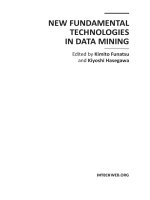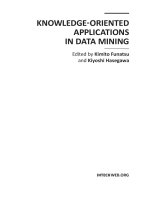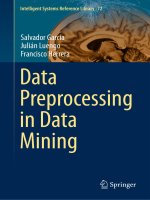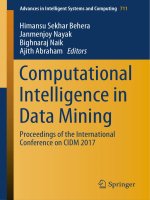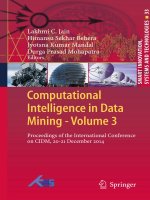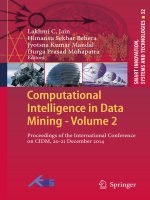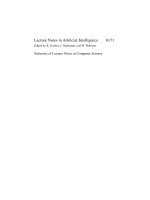IT training ensemble methods in data mining improving accuracy through combining predictions seni elder 2010 02 24
Bạn đang xem bản rút gọn của tài liệu. Xem và tải ngay bản đầy đủ của tài liệu tại đây (2.6 MB, 127 trang )
Ensemble Methods in
Data Mining:
Improving Accuracy
Through Combining Predictions
Synthesis Lectures on Data
Mining and Knowledge
Discovery
Editor
Robert Grossman, University of Illinois, Chicago
Ensemble Methods in Data Mining: Improving Accuracy Through Combining
Predictions
Giovanni Seni and John F. Elder
2010
Modeling and Data Mining in Blogosphere
Nitin Agarwal and Huan Liu
2009
Copyright © 2010 by Morgan & Claypool
All rights reserved. No part of this publication may be reproduced, stored in a retrieval system, or transmitted in
any form or by any means—electronic, mechanical, photocopy, recording, or any other except for brief quotations in
printed reviews, without the prior permission of the publisher.
Ensemble Methods in Data Mining: Improving Accuracy Through Combining Predictions
Giovanni Seni and John F. Elder
www.morganclaypool.com
ISBN: 9781608452842
ISBN: 9781608452859
paperback
ebook
DOI 10.2200/S00240ED1V01Y200912DMK002
A Publication in the Morgan & Claypool Publishers series
SYNTHESIS LECTURES ON DATA MINING AND KNOWLEDGE DISCOVERY
Lecture #2
Series Editor: Robert Grossman, University of Illinois, Chicago
Series ISSN
Synthesis Lectures on Data Mining and Knowledge Discovery
Print 2151-0067 Electronic 2151-0075
Ensemble Methods in
Data Mining:
Improving Accuracy
Through Combining Predictions
Giovanni Seni
Elder Research, Inc. and Santa Clara University
John F. Elder
Elder Research, Inc. and University of Virginia
SYNTHESIS LECTURES ON DATA MINING AND KNOWLEDGE DISCOVERY
#2
M
&C
Morgan
& cLaypool publishers
ABSTRACT
Ensemble methods have been called the most influential development in Data Mining and Machine
Learning in the past decade. They combine multiple models into one usually more accurate than
the best of its components. Ensembles can provide a critical boost to industrial challenges – from
investment timing to drug discovery, and fraud detection to recommendation systems – where
predictive accuracy is more vital than model interpretability.
Ensembles are useful with all modeling algorithms, but this book focuses on decision trees
to explain them most clearly. After describing trees and their strengths and weaknesses, the authors
provide an overview of regularization – today understood to be a key reason for the superior performance of modern ensembling algorithms. The book continues with a clear description of two
recent developments: Importance Sampling (IS) and Rule Ensembles (RE). IS reveals classic ensemble
methods – bagging, random forests, and boosting – to be special cases of a single algorithm, thereby
showing how to improve their accuracy and speed. REs are linear rule models derived from decision
tree ensembles. They are the most interpretable version of ensembles, which is essential to applications such as credit scoring and fault diagnosis. Lastly, the authors explain the paradox of how
ensembles achieve greater accuracy on new data despite their (apparently much greater) complexity.
This book is aimed at novice and advanced analytic researchers and practitioners – especially
in Engineering, Statistics, and Computer Science. Those with little exposure to ensembles will learn
why and how to employ this breakthrough method, and advanced practitioners will gain insight into
building even more powerful models. Throughout, snippets of code in R are provided to illustrate
the algorithms described and to encourage the reader to try the techniques1 .
The authors are industry experts in data mining and machine learning who are also adjunct
professors and popular speakers. Although early pioneers in discovering and using ensembles, they
here distill and clarify the recent groundbreaking work of leading academics (such as Jerome Friedman) to bring the benefits of ensembles to practitioners.
The authors would appreciate hearing of errors in or suggested improvements to this book,
and may be emailed at and Errata and
updates will be available from www.morganclaypool.com
KEYWORDS
ensemble methods, rule ensembles, importance sampling, boosting, random forest, bagging, regularization, decision trees, data mining, machine learning, pattern recognition,
model interpretation, model complexity, generalized degrees of freedom
1 R is an Open Source Language and environment for data analysis and statistical modeling available through the Comprehensive
R Archive Network (CRAN). The R system’s library packages offer extensive functionality, and be downloaded form http://
cran.r-project.org/ for many computing platforms. The CRAN web site also has pointers to tutorial and comprehensive
documentation. A variety of excellent introductory books are also available; we particularly like Introductory Statistics with R by
Peter Dalgaard and Modern Applied Statistics with S by W.N. Venables and B.D. Ripley.
To the loving memory of our fathers,
Tito and Fletcher
ix
Contents
Acknowledgments . . . . . . . . . . . . . . . . . . . . . . . . . . . . . . . . . . . . . . . . . . . . . . . . . . . . . . . . . . xiii
Foreword by Jaffray Woodriff . . . . . . . . . . . . . . . . . . . . . . . . . . . . . . . . . . . . . . . . . . . . . . . . . xv
Foreword by Tin Kam Ho . . . . . . . . . . . . . . . . . . . . . . . . . . . . . . . . . . . . . . . . . . . . . . . . . . . xvii
1
2
3
Ensembles Discovered . . . . . . . . . . . . . . . . . . . . . . . . . . . . . . . . . . . . . . . . . . . . . . . . . . . . . . . 1
1.1
Building Ensembles . . . . . . . . . . . . . . . . . . . . . . . . . . . . . . . . . . . . . . . . . . . . . . . . . . . . . . . . 4
1.2
Regularization . . . . . . . . . . . . . . . . . . . . . . . . . . . . . . . . . . . . . . . . . . . . . . . . . . . . . . . . . . . . . 6
1.3
Real-World Examples: Credit Scoring + the Netflix Challenge . . . . . . . . . . . . . . . . . . 7
1.4
Organization of This Book . . . . . . . . . . . . . . . . . . . . . . . . . . . . . . . . . . . . . . . . . . . . . . . . . . 8
Predictive Learning and Decision Trees . . . . . . . . . . . . . . . . . . . . . . . . . . . . . . . . . . . . . . . 11
2.1
Decision Tree Induction Overview . . . . . . . . . . . . . . . . . . . . . . . . . . . . . . . . . . . . . . . . . . 15
2.2
Decision Tree Properties . . . . . . . . . . . . . . . . . . . . . . . . . . . . . . . . . . . . . . . . . . . . . . . . . . . 18
2.3
Decision Tree Limitations . . . . . . . . . . . . . . . . . . . . . . . . . . . . . . . . . . . . . . . . . . . . . . . . . . 19
Model Complexity, Model Selection and Regularization . . . . . . . . . . . . . . . . . . . . . . . 21
3.1
What is the “Right” Size of a Tree? . . . . . . . . . . . . . . . . . . . . . . . . . . . . . . . . . . . . . . . . . . 21
3.2
Bias-Variance Decomposition . . . . . . . . . . . . . . . . . . . . . . . . . . . . . . . . . . . . . . . . . . . . . . . 22
3.3
Regularization . . . . . . . . . . . . . . . . . . . . . . . . . . . . . . . . . . . . . . . . . . . . . . . . . . . . . . . . . . . . 25
3.3.1 Regularization and Cost-Complexity Tree Pruning
3.3.2 Cross-Validation
26
3.3.3 Regularization via Shrinkage
28
3.3.4 Regularization via Incremental Model Building
3.3.5 Example
25
34
3.3.6 Regularization Summary
37
32
x
CONTENTS
4
Importance Sampling and the Classic Ensemble Methods . . . . . . . . . . . . . . . . . . . . . .39
4.1
Importance Sampling . . . . . . . . . . . . . . . . . . . . . . . . . . . . . . . . . . . . . . . . . . . . . . . . . . . . . . 42
4.1.1 Parameter Importance Measure
4.1.2 Perturbation Sampling
43
45
4.2
Generic Ensemble Generation . . . . . . . . . . . . . . . . . . . . . . . . . . . . . . . . . . . . . . . . . . . . . . 46
4.3
Bagging . . . . . . . . . . . . . . . . . . . . . . . . . . . . . . . . . . . . . . . . . . . . . . . . . . . . . . . . . . . . . . . . . . 48
4.3.1 Example
49
4.3.2 Why it Helps?
53
4.4
Random Forest . . . . . . . . . . . . . . . . . . . . . . . . . . . . . . . . . . . . . . . . . . . . . . . . . . . . . . . . . . . . 54
4.5
AdaBoost . . . . . . . . . . . . . . . . . . . . . . . . . . . . . . . . . . . . . . . . . . . . . . . . . . . . . . . . . . . . . . . . 56
4.5.1 Example
58
4.5.2 Why the Exponential Loss?
59
4.5.3 AdaBoost’s Population Minimizer
5
4.6
Gradient Boosting . . . . . . . . . . . . . . . . . . . . . . . . . . . . . . . . . . . . . . . . . . . . . . . . . . . . . . . . . 61
4.7
MART . . . . . . . . . . . . . . . . . . . . . . . . . . . . . . . . . . . . . . . . . . . . . . . . . . . . . . . . . . . . . . . . . . . 62
4.8
Parallel vs. Sequential Ensembles . . . . . . . . . . . . . . . . . . . . . . . . . . . . . . . . . . . . . . . . . . . .63
Rule Ensembles and Interpretation Statistics . . . . . . . . . . . . . . . . . . . . . . . . . . . . . . . . . 65
5.1
Rule Ensembles . . . . . . . . . . . . . . . . . . . . . . . . . . . . . . . . . . . . . . . . . . . . . . . . . . . . . . . . . . . 65
5.2
Interpretation . . . . . . . . . . . . . . . . . . . . . . . . . . . . . . . . . . . . . . . . . . . . . . . . . . . . . . . . . . . . . 67
5.2.1 Simulated Data Example
68
5.2.2 Variable Importance
73
5.2.3 Partial Dependences
74
5.2.4 Interaction Statistic
6
60
74
5.3
Manufacturing Data Example . . . . . . . . . . . . . . . . . . . . . . . . . . . . . . . . . . . . . . . . . . . . . . 75
5.4
Summary . . . . . . . . . . . . . . . . . . . . . . . . . . . . . . . . . . . . . . . . . . . . . . . . . . . . . . . . . . . . . . . . . 78
Ensemble Complexity . . . . . . . . . . . . . . . . . . . . . . . . . . . . . . . . . . . . . . . . . . . . . . . . . . . . . . . 81
6.1
Complexity . . . . . . . . . . . . . . . . . . . . . . . . . . . . . . . . . . . . . . . . . . . . . . . . . . . . . . . . . . . . . . . 81
6.2
Generalized Degrees of Freedom . . . . . . . . . . . . . . . . . . . . . . . . . . . . . . . . . . . . . . . . . . . . 83
6.3
Examples: Decision Tree Surface with Noise . . . . . . . . . . . . . . . . . . . . . . . . . . . . . . . . . 83
CONTENTS
6.4
R Code for GDF and Example . . . . . . . . . . . . . . . . . . . . . . . . . . . . . . . . . . . . . . . . . . . . . 88
6.5
Summary and Discussion . . . . . . . . . . . . . . . . . . . . . . . . . . . . . . . . . . . . . . . . . . . . . . . . . . .89
A
AdaBoost Equivalence to FSF Procedure . . . . . . . . . . . . . . . . . . . . . . . . . . . . . . . . . . . . . 93
B
Gradient Boosting and Robust Loss Functions . . . . . . . . . . . . . . . . . . . . . . . . . . . . . . . . 97
Bibliography . . . . . . . . . . . . . . . . . . . . . . . . . . . . . . . . . . . . . . . . . . . . . . . . . . . . . . . . . . . . . . . 101
Authors’ Biographies . . . . . . . . . . . . . . . . . . . . . . . . . . . . . . . . . . . . . . . . . . . . . . . . . . . . . . . 107
xi
Acknowledgments
We would like to thank the many people who contributed to the conception and completion of this
project. Giovanni had the privilege of meeting with Jerry Friedman regularly to discuss many of
the statistical concepts behind ensembles. Prof. Friedman’s influence is deep. Bart Goethels and the
organizers of ACM-KDD07 first welcomed our tutorial proposal on the topic.Tin Kam Ho favorably
reviewed the book idea, Keith Bettinger offered many helpful suggestions on the manuscript, and
Matt Strampe assisted with R code. The staff at Morgan & Claypool – especially executive editor
Diane Cerra – were diligent and patient in turning the manuscript into a book. Finally, we would
like to thank our families for their love and support.
Giovanni Seni and John F. Elder
January 2010
Foreword by Jaffray Woodriff
John Elder is a well-known expert in the field of statistical prediction. He is also a good friend
who has mentored me about many techniques for mining complex data for useful information. I
have been quite fortunate to collaborate with John on a variety of projects, and there must be a good
reason that ensembles played the primary role each time.
I need to explain how we met, as ensembles are responsible! I spent my four years at the
University of Virginia investigating the markets. My plan was to become an investment manager
after I graduated. All I needed was a profitable technical style that fit my skills and personality (that’s
all!). After I graduated in 1991, I followed where the data led me during one particular caffeinefueled, double all-nighter. In a fit of “crazed trial and error” brainstorming I stumbled upon the
winning concept of creating one “super-model” from a large and diverse group of base predictive
models.
After ten years of combining models for investment management, I decided to investigate
where my ideas fit in the general academic body of work. I had moved back to Charlottesville after
a stint as a proprietary trader on Wall Street, and I sought out a local expert in the field.
I found John’s firm, Elder Research, on the web and hoped that they’d have the time to talk to
a data mining novice. I quickly realized that John was not only a leading expert on statistical learning,
but a very accomplished speaker popularizing these methods. Fortunately for me, he was curious to
talk about prediction and my ideas. Early on, he pointed out that my multiple model method for
investing described by the statistical prediction term, “ensemble.”
John and I have worked together on interesting projects over the past decade. I teamed
with Elder Research to compete in the KDD Cup in 2001. We wrote an extensive proposal for a
government grant to fund the creation of ensemble-based research and software. In 2007 we joined
up to compete against thousands of other teams on the Netflix Prize - achieving a third-place ranking
at one point (thanks partly to simple ensembles). We even pulled a brainstorming all-nighter coding
up our user rating model, which brought back fond memories of that initial breakthrough so many
years before.
The practical implementations of ensemble methods are enormous. Most current implementations of them are quite primitive and this book will definitely raise the state of the art. Giovanni
Seni’s thorough mastery of the cutting-edge research and John Elder’s practical experience have
combined to make an extremely readable and useful book.
Looking forward, I can imagine software that allows users to seamlessly build ensembles in
the manner, say, that skilled architects use CAD software to create design images. I expect that
xvi
FOREWORD BY JAFFRAY WOODRIFF
Giovanni and John will be at the forefront of developments in this area, and, if I am lucky, I will be
involved as well.
Jaffray Woodriff
CEO, Quantitative Investment Management
Charlottesville, Virginia
January 2010
[Editor’s note: Mr. Woodriff ’s investment firm has experienced consistently positive results, and has
grown to be the largest hedge fund manager in the South-East U.S.]
Foreword by Tin Kam Ho
Fruitful solutions to a challenging task have often been found to come from combining an
ensemble of experts. Yet for algorithmic solutions to a complex classification task, the utilities of
ensembles were first witnessed only in the late 1980’s, when the computing power began to support
the exploration and deployment of a rich set of classification methods simultaneously. The next
two decades saw more and more such approaches come into the research arena, and the development of several consistently successful strategies for ensemble generation and combination. Today,
while a complete explanation of all the elements remains elusive, the ensemble methodology has
become an indispensable tool for statistical learning. Every researcher and practitioner involved in
predictive classification problems can benefit from a good understanding of what is available in this
methodology.
This book by Seni and Elder provides a timely, concise introduction to this topic. After an
intuitive, highly accessible sketch of the key concerns in predictive learning, the book takes the
readers through a shortcut into the heart of the popular tree-based ensemble creation strategies, and
follows that with a compact yet clear presentation of the developments in the frontiers of statistics,
where active attempts are being made to explain and exploit the mysteries of ensembles through
conventional statistical theory and methods. Throughout the book, the methodology is illustrated
with varied real-life examples, and augmented with implementations in R-code for the readers
to obtain first-hand experience. For practitioners, this handy reference opens the door to a good
understanding of this rich set of tools that holds high promises for the challenging tasks they face.
For researchers and students, it provides a succinct outline of the critically relevant pieces of the vast
literature, and serves as an excellent summary for this important topic.
The development of ensemble methods is by no means complete. Among the most interesting
open challenges are a more thorough understanding of the mathematical structures, mapping of the
detailed conditions of applicability, finding scalable and interpretable implementations, dealing with
incomplete or imbalanced training samples, and evolving models to adapt to environmental changes.
It will be exciting to see this monograph encourage talented individuals to tackle these problems in
the coming decades.
Tin Kam Ho
Bell Labs, Alcatel-Lucent
January 2010
1
CHAPTER
1
Ensembles Discovered
…and in a multitude of counselors there is safety.
Proverbs 24:6b
A wide variety of competing methods are available for inducing models from data, and their
relative strengths are of keen interest. The comparative accuracy of popular algorithms depends
strongly on the details of the problems addressed, as shown in Figure 1.1 (from Elder and Lee
(1997)), which plots the relative out-of-sample error of five algorithms for six public-domain problems. Overall, neural network models did the best on this set of problems, but note that every
algorithm scored best or next-to-best on at least two of the six data sets.
Relative Performance Examples: 5 Algorithms on 6 Datasets
Error R
Relative to P
Peer Techn
niques (loweer is better))
(John Elder, Elder Research & Stephen Lee, U. Idaho, 1997)
1 00
1.00
.90
80
.80
Neural Network
Logistic Regression
Linear Vector Quantization
Projection Pursuit Regression
Decision Tree
.70
60
.60
.50
40
.40
.30
20
.20
.10
.00
00
Diabetes
Gaussian
Hypothyroid
German Credit
Waveform
Investment
Figure 1.1: Relative out-of-sample error of five algorithms on six public-domain problems (based
on Elder and Lee (1997)).
2
1. ENSEMBLES DISCOVERED
How can we tell, ahead of time, which algorithm will excel for a given problem? Michie et al.
(1994) addressed this question by executing a similar but larger study (23 algorithms on 22 data
sets) and building a decision tree to predict the best algorithm to use given the properties of a data
set1 . Though the study was skewed toward trees — they were 9 of the 23 algorithms, and several of
the (academic) data sets had unrealistic thresholds amenable to trees — the study did reveal useful
lessons for algorithm selection (as highlighted in Elder, J. (1996a)).
Still, there is a way to improve model accuracy that is easier and more powerful than judicious
algorithm selection: one can gather models into ensembles. Figure 1.2 reveals the out-of-sample
accuracy of the models of Figure 1.1 when they are combined four different ways, including averaging, voting, and “advisor perceptrons” (Elder and Lee, 1997). While the ensemble technique of
advisor perceptrons beats simple averaging on every problem, the difference is small compared to the
difference between ensembles and the single models. Every ensemble method competes well here
against the best of the individual algorithms.
This phenomenon was discovered by a handful of researchers, separately and simultaneously,
to improve classification whether using decision trees (Ho, Hull, and Srihari, 1990), neural networks (Hansen and Salamon, 1990), or math theory (Kleinberg, E., 1990). The most influential
early developments were by Breiman, L. (1996) with Bagging, and Freund and Shapire (1996) with
AdaBoost (both described in Chapter 4).
One of us stumbled across the marvel of ensembling (which we called “model fusion” or
“bundling”) while striving to predict the species of bats from features of their echo-location signals (Elder, J., 1996b)2 . We built the best model we could with each of several very different
algorithms, such as decision trees, neural networks, polynomial networks, and nearest neighbors
(see Nisbet et al. (2009) for algorithm descriptions). These methods employ different basis functions and training procedures, which causes their diverse surface forms – as shown in Figure 1.3 –
and often leads to surprisingly different prediction vectors, even when the aggregate performance is
very similar.
The project goal was to classify a bat’s species noninvasively, by using only its “chirps.” University of Illinois Urbana-Champaign biologists captured 19 bats, labeled each as one of 6 species, then
recorded 98 signals, from which UIUC engineers calculated 35 time-frequency features3 . Figure 1.4
illustrates a two-dimensional projection of the data where each class is represented by a different
color and symbol. The data displays useful clustering but also much class overlap to contend with.
Each bat contributed 3 to 8 signals, and we realized that the set of signals from a given bat had
to be kept together (in either training or evaluation data) to fairly test the model’s ability to predict
a species of an unknown bat. That is, any bat with a signal in the evaluation data must have no other
1The researchers (Michie et al., 1994, Section 10.6) examined the results of one algorithm at a time and built a C4.5 decision
tree (Quinlan, J., 1992) to separate those datasets where the algorithm was “applicable” (where it was within a tolerance of
the best algorithm) to those where it was not. They also extracted rules from the tree models and used an expert system to
adjudicate between conflicting rules to maximize net “information score.” The book is online at ds.
ac.uk/∼charles/statlog/whole.pdf
2Thanks to collaboration with Doug Jones and his EE students at the University of Illinois, Urbana-Champaign.
3 Features such as low frequency at the 3-decibel level, time position of the signal peak, and amplitude ratio of 1st and 2nd harmonics.
3
Error R
Relative to P
Peer Technniques (loweer is better))
Ensemble methods all improve performance
1 00
1.00
.90
.80
80
.70
.60
60
.50
.40
40
Advisor Perceptron
AP weighted average
Vote
Average
.30
20
.20
.10
.00
00
Diabetes
Gaussian
Hypothyroid
German Credit
Waveform
Investment
Figure 1.2: Relative out-of-sample error of four ensemble methods on the problems of Figure 1.1(based
on Elder and Lee (1997)).
signals from it in training. So, evaluating the performance of a model type consisted of building
and cross-validating 19 models and accumulating the out-of-sample results (– a leave-one-bat-out
method).
On evaluation, the baseline accuracy (always choosing the plurality class) was 27%. Decision trees got 46%, and a tree algorithm that was improved to look two-steps ahead to choose
splits (Elder, J., 1996b) got 58%. Polynomial networks got 64%. The first neural networks tried
achieved only 52%. However, unlike the other methods, neural networks don’t select variables; when
the inputs were then pruned in half to reduce redundancy and collinearity, neural networks improved
to 63% accuracy. When the inputs were pruned further to be only the 8 variables the trees employed,
neural networks improved to 69% accuracy out-of-sample. (This result is a clear demonstration of
the need for regularization, as described in Chapter 3, to avoid overfit.) Lastly, nearest neighbors,
using those same 8 variables for dimensions, matched the neural network score of 69%.
Despite their overall scores being identical, the two best models – neural network and nearest
neighbor – disagreed a third of the time; that is, they made errors on very different regions of the
data. We observed that the more confident of the two methods was right more often than not.
4
1. ENSEMBLES DISCOVERED
(Their estimates were between 0 and 1 for a given class; the estimate more close to an extreme was
usually more correct.) Thus, we tried averaging together the estimates of four of the methods – twostep decision tree, polynomial network, neural network, and nearest neighbor – and achieved 74%
accuracy – the best of all. Further study of the lessons of each algorithm (such as when to ignore an
estimate due to its inputs clearly being outside the algorithm’s training domain) led to improvement
reaching 80%. In short, it was discovered to be possible to break through the asymptotic performance
ceiling of an individual algorithm by employing the estimates of multiple algorithms. Our fascination
with what came to be known as ensembling began.
1.1
BUILDING ENSEMBLES
Building an ensemble consists of two steps: (1) constructing varied models and (2) combining their estimates (see Section 4.2). One may generate component models by, for instance, varying case weights,
data values, guidance parameters, variable subsets, or partitions of the input space. Combination can
be accomplished by voting, but is primarily done through model estimate weights, with gating and advisor perceptrons as special cases. For example, Bayesian model averaging sums estimates of possible
Figure 1.3: Example estimation surfaces for five modeling algorithms. Clockwise from top left: decision tree, Delaunay planes (based on Elder, J. (1993)), nearest neighbor, polynomial network (or neural
network), kernel.
1.1. BUILDING ENSEMBLES
t10
Var4
\
\
bw
\
\
\
Figure 1.4: Sample projection of signals for 6 different bat species.
models, weighted by their posterior evidence. Bagging (bootsrap aggregating; Breiman, L. (1996))
bootstraps the training data set (usually to build varied decision trees) and takes the majority vote or
the average of their estimates (see Section 4.3). Random Forest (Ho, T., 1995; Breiman, L., 2001)
adds a stochastic component to create more “diversity” among the trees being combined (see Section 4.4) AdaBoost (Freund and Shapire, 1996) and ARCing (Breiman, L., 1996) iteratively build
models by varying case weights (up-weighting cases with large current errors and down-weighting
those accurately estimated) and employs the weighted sum of the estimates of the sequence of models
(see Section 4.5). Gradient Boosting (Friedman, J., 1999, 2001) extended the AdaBoost algorithm
to a variety of error functions for regression and classification (see Section 4.6).
The Group Method of Data Handling (GMDH) (Ivakhenko, A., 1968) and its descendent,
Polynomial Networks (Barron et al., 1984; Elder and Brown, 2000), can be thought of as early ensemble techniques.They build multiple layers of moderate-order polynomials, fit by linear regression,
5
6
1. ENSEMBLES DISCOVERED
where variety arises from different variable sets being employed by each node. Their combination is
nonlinear since the outputs of interior nodes are inputs to polynomial nodes in subsequent layers.
Network construction is stopped by a simple cross-validation test (GMDH) or a complexity penalty.
An early popular method, Stacking (Wolpert, D., 1992) employs neural networks as components
(whose variety can stem from simply using different guidance parameters, such as initialization
weights), combined in a linear regression trained on leave-1-out estimates from the networks.
Models have to be individually good to contribute to ensembling, and that requires knowing
when to stop; that is, how to avoid overfit – the chief danger in model induction, as discussed next.
1.2
REGULARIZATION
A widely held principle in Statistical and Machine Learning model inference is that accuracy and
simplicity are both desirable. But there is a tradeoff between the two: a flexible (more complex) model
is often needed to achieve higher accuracy, but it is more susceptible to overfitting and less likely to
generalize well. Regularization techniques ”damp down” the flexibility of a model fitting procedure
by augmenting the error function with a term that penalizes model complexity. Minimizing the
augmented error criterion requires a certain increase in accuracy to “pay” for the increase in model
complexity (e.g., adding another term to the model). Regularization is today understood to be one
of the key reasons for the superior performance of modern ensembling algorithms.
An influential paper was Tibshirani’s introduction of the Lasso regularization technique for
linear models (Tibshirani, R., 1996). The Lasso uses the sum of the absolute value of the coefficients
in the model as the penalty function and had roots in work done by Breiman on a coefficient
post-processing technique which he had termed Garotte (Breiman et al., 1993).
Another important development came with the LARS algorithm by Efron et al. (2004), which
allows for an efficient iterative calculation of the Lasso solution. More recently, Friedman published
a technique called Path Seeker (PS) that allows combining the Lasso penalty with a variety of
loss (error) functions (Friedman and Popescu, 2004), extending the original Lasso paper which was
limited to the Least-Squares loss.
Careful comparison of the Lasso penalty with alternative penalty functions (e.g., using the
sum of the squares of the coefficients) led to an understanding that the penalty function has two
roles: controlling the “sparseness” of the solution (the number of coefficients that are non-zero) and
controlling the magnitude of the non-zero coefficients (“shrinkage”). This led to development of
the Elastic Net (Zou and Hastie, 2005) family of penalty functions which allow searching for the
best shrinkage/sparseness tradeoff according to characteristics of the problem at hand (e.g., data
size, number of input variables, correlation among these variables, etc.). The Coordinate Descent
algorithm of Friedman et al. (2008) provides fast solutions for the Elastic Net.
Finally, an extension of the Elastic Net family to non-convex members producing sparser
solutions (desirable when the number of variables is much larger than the number of observations)
is now possible with the Generalized Path Seeker algorithm (Friedman, J., 2008).

